In 1953, Atlas tried to revive Captain America and Bucky. It didn’t work, and it annoyed Simon and Kirby because they thought it infringed on their work on Captain America. So they went out to outdo Atlas’ version. What they came up with was Fighting American and Speedboy. Initially, Fighting American fought Communists the way Captain America fought Nazis. It seems neither Kirby nor Simon liked dictatorships of any stripe.
So Fighting American and Speedboy’s first issue has them as straight dramatic heroes. But then McCarthy fell over. The alcoholic who had falsified accusations against his opponent Robert La Follette Jr in the Republican primary, who had defeated that opponent with the backing of a Communist-controlled union, who had become famous by making allegations of Communist infiltration which he never substantiated to any extent, and who is almost completely forgotten for having made similar accusations regarding homosexuality, changed the course of a comic book.
From the second issue on, Fighting American and Speedboy become a satire with opponents like Poison Ivan, Hotsky Trotsky, and Space Face (who may later have been rejigged as the Space Phantom).
There were only about ten issues of Fighting American. It didn’t sell well. But while it was there it had Speedboy The Wonder Kid. In this case, The Kid has no name except the one he uses with the mask. Even when he isn’t wearing his mask, the narrative refers to him as Speedboy.
It is much the same costume as Bucky or Sandy: blue shirt with a collar, slightly more complex boots and gloves. There is an S with little Captain America wings on it on his chest. But it varies in the short run of the comic. The trunks are red and the leggings blue, or the other way around, of they are both red or they are both blue.
But his role is the same. Though Fighting American has super powers of speed, strength, and agility, Speedboy is just plain plucky. In fact, Fighting American picks him up when a bomb goes off at the TV station where Fighting American works under the guise of his dead brother, Johnny Flagg. Since Speedboy is helpful, Fighting American, the guy with the super powers, puts a costume on the kid and throws him at villains who make Batman’s rogues gallery look normal. Speedboy had no personality except his pluck, no social life, no friends except Fighting American.
After leaving Bucky, Sandy and Speedboy, Jack Kirby took up the story of Rick Jones when he and Stan Lee were making Marvel a major force in superhero fiction. Rick Jones is a sidekick specialist. But as a sidekick, he is a bit of a nursemaid to his mentor. He tells the Hulk to leave an area to keep the big guy out of trouble. He berates Captain America, saying other people had lost someone in the War, too, get over it. He is the crutch by which Captain Marvel gets back to this dimension from the Negative Zone. He is like an ambitious girl of poor parents passed among frat boys.
But he is the sidekick who is always in training. He tries putting on Bucky’s costume, which just freaks Cap out. For a long time after that he doesn’t even get to wear a costume. All he does is have to take care of his hero and seek his hero’s approval, telling his hero how smart and wise they were. It actually does sound creepy when put that way, but it is accurate.
He was originally the kid who Bruce Banner saved from becoming irradiated. Strangely, though Spider-Man’s guilt over the death of his uncle has been a staple topic for over 50 years, Jones’s sense of guilt is neither as constant nor as consistent.
Jones became a potential sidekick to Captain America and did his plucky best to be worthy of the honor. Jones was considered for full superhero status and it seems was only rejected because of Captain America’s post-traumatic stress disorder over the loss of The Kid that he put in constant danger. But under Kirby and probably because of him, Rick Jones got his own, stand-up-for-himself-and-be-right-about-it personality. It was a step too far for others.
Out of Kirby’s hands, Rick Jones was increasingly the tool of plot rather than a character in his own right. He upstages his mentors, knowing better than them. But he cannot grasp cancer in a friend, which sends him into histrionics. He suffers overwhelming self-doubt, saying he should have stuck with the Teen Brigade, ignoring completely the fact he was in a founder’s and leadership role there. He even gets to wear the Bucky costume.
After Captain Marvel he joins with ROM the Spaceknight, whom he becomes sidekick to despite having cancer at the time. In real life that would be just pathological, in fiction it screams of just grabbing associated ideas as if they produce a character.
On and off he’s with the Hulk. Again, in real life that would scream an abusive relationship based on poles of guilt and fear. In terms of publishing, it seems to indicate there is a surge of sales when Rick shows up and those sales drift away. Rick Jones can provide a spike in sales but cannot sustain them. Partly, that may because he’s been glued to every passing fad or plot gimmick.
They retconned Bucky as being named James Buchanan Barnes, named after President James Buchanan. Imitating this, Rick Jones was retconned into being named Richard Milhouse Jones, after Richard Nixon. However, that was done in the early ’70s when Rick Jones was a teenager. Nixon didn’t become President until 1968, so Rick Jones must have been named after the Nixon when he was Vice President to Eisenhower. But the gimmick outweighed believability.
As to The Kid, look what’s happened to his incarnations. Bucky is now alive but as Winter Soldier and a former Captain America. He looks on his years as Bucky with discomfort. That version of Bucky has been retconned to a soldier doing the assassinations adult soldiers would feel uncomfortable with – like no adult soldier was ever a sniper or in special ops.
Sandy the Golden Boy disappeared when the tide of superheroes receded. When the tide returned, Sandy did not. He was still forgotten like comic reliefs Doiby Dickles and Etta Candy, until he was entirely remade. He did not come back until the ‘0s and he was made into a tragedy, crippled by a failed experiment of his mentor. He has since been remolded into a version of his now-dead mentor. No new version of Sandy the Golden Boy was ever created.
Speedboy lasted about ten issues. Despite the idea some have that Fighting American is Kirby’s or Simon and Kirby’s greatest work, they seem to pass over Speedboy in silence.
Rick Jones still spends his time on the sidelines.
Kirby once said he would be OK with the revival of Bucky, because Bucky represented teenagers. Kirby spent years telling us variations on the story of The Kid. But teenagers are not the market for comic books any more. And teenagers have different stories, now. They aren’t trying to please a hero, they’re trying to claw their place in a place that wants to exclude them. They don’t have faith in the powers that be, and in comparison to what they have to face, Watergate was nothing.
The story of The Kid is over. The idea of the marginally qualified superhero fighting to make the grade does not resonate. These days it’s the outsider who shows up better qualified than the “powers that be” that’s the story people react to – look at the recent superhero movies.
Just putting on a mask is not enough any more. The Kid is not enough any more, and so Kirby is not remembered for the guy who is like us, but for the superhumans who are most unlike us. We remember him for the “other.” Fortunately, Kirby was a genius at telling that story, too.

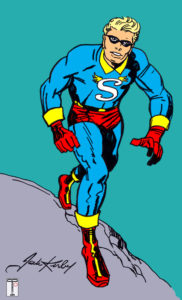
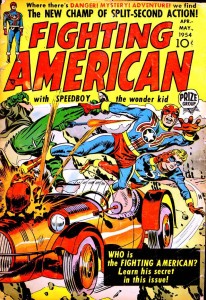
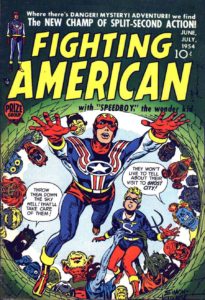
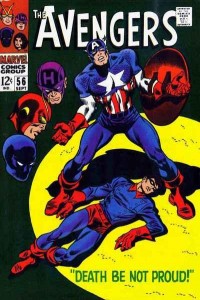
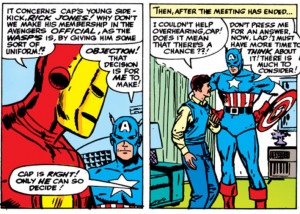
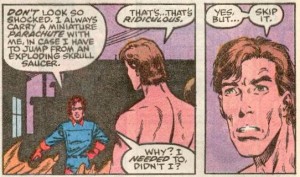
Comments are closed.